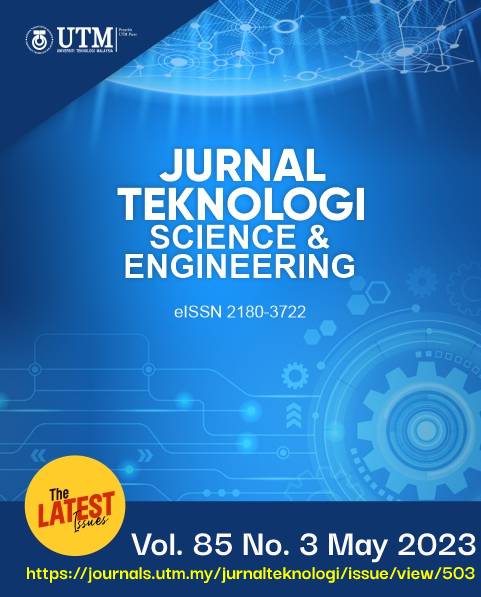INFLUENCE OF DOUBLE CALCINATION-MILLING ROUTE ON THE STRUCTURAL AND MICROSTRUCTURAL PROPERTIES OF LEAD-FREE K0.5NA0.5NBO3 (KNN) CERAMICS
DOI:
https://doi.org/10.11113/jurnalteknologi.v85.19202Keywords:
Potassium Sodium Niobate, piezoelectric ceramic, double calcination, solid state method, sinteringAbstract
Potassium sodium niobate (KNN) has always been one of the most potential candidates to replace lead-based piezoelectric ceramics due to its strong piezoelectric properties and environmentally friendly composition. A strong piezoelectric property is constantly influenced by the sample's densification as well as its microstructural characteristics. One of the current main issues with this KNN lead-free piezoelectric material is the difficulty in creating high-density samples by conventional preparation and sintering. Thus, KNN lead-free ceramics were synthesised using an improved solid-state method by introducing the double calcination-milling route to this process. The outcome demonstrates that, despite the presence of additional KNN secondary phases, the double calcination-milling approach contributed to the early creation of the KNN phase. When sintered pellets are subjected to a double calcination milling process, the XRD pattern revealed that the main peaks of the sample are indexed to orthorhombic K0.5Na0.5NbO3. The double calcination KNN pellet have a relative density of 90% densification which is slightly higher than that of single calcination KNN pellet which shows 88% densification.
References
Hao, J., Li, W., Zhai, J., and Chen, H. 2019. Progress in High-strain Perovskite Piezoelectric Ceramics. Materials Science and Engineering R: Reports. 135: 1-57. Doi:10.1016/j.mser.2018.08.001.
Kumar, A., Sharma, A., Kumar, R., Vaish, R., Chauhan, V. S., and Bowen, C. R. 2015. Piezoelectric Materials Selection for Sensor Applications using Finite Element and Multiple Attribute Decision-making Approaches. Journal of Advanced Dielectrics. 5(1). Doi:10.1142/S2010135X15500034.
Moriana, A. D., and Zhang, S. 2018. Lead-free Textured Piezoceramics using Tape Casting: A Review. Journal of Materiomics. 4(4): 277-303. Doi:10.1016/j.jmat.2018.09.006.
Izzuddin, I., Mohammad, M. H., Zainuddin, Z., and Janil, N. H. 2019. Piezoelectric Enhancements in K0.5Na0.5NbO3-based Ceramics via Structural Evolutions. Ceramics International. 45(14): 17204-17209. Doi:10.1016/j.ceramint.2019.05.275.
Khorrami, G. H., Kompany, A., and Khorsand Zak, A. 2013. A Facile Sol-gel Approach to Synthesize KNN Nanoparticles at Low Temperature. Materials Letters. 110: 172-175. Doi:10.1016/j.matlet.2013.07.115.
Piskin, C., Karacasulu, L., Bortolotti, M., and Vakifahmetoglu, C. 2021. Synthesis of Potassium–sodium Niobate (KNN) from NbO2. Open Ceramics. 7. Doi:10.1016/j.oceram.2021.100159.
Li, H., Hao, Y., Lin, Z., et al. 2022. (K,Na)NbO3 Lead-free Piezoceramics Prepared by Microwave Sintering and Solvothermal Powder Synthesis. Solid State Communications. 353: 114871. Doi:10.1016/J.SSC.2022.114871.
Feizpour, M., Ebadzadeht, T., and Jenko, D. 2015. Solid-state Sintering of (K0.5Na0.5)NbO3 Synthesized from an Alkali-carbonate-based Low-temperature Calcined Powder. Materiali in Tehnologije. 49(6): 975-982. Doi:10.17222/mit.2015.315
Rani, R., Sharma, S., Quaglio, M., et al. 2017. A Novel Low Temperature Synthesis of KNN Nanoparticles by Facile Wet Chemical Method. Materials Sciences and Applications. 08(03): 247-257. Doi:10.4236/msa.2017.83017.
Popovič, A., Bencze, L., Koruza, J., and Malič, B. 2015. Vapour Pressure and Mixing Thermodynamic Properties of the KNbO3-NaNbO3 System. RSC Advances. 5(93): 76249-76256. Doi:10.1039/c5ra11874c.
. Quintero, M. C., Rincón, M., Osorio-Guillén, J. M., López, D., and Londoño-Badillo, F. A. 2019. Grinding Methods Effects on the Synthesis of Potassium-Sodium Niobate Powders by Oxide Mixing. TecnoLógicas. 22(46): 15-23. Doi:10.22430/22565337.1269.
Ahmad, N. A., Aziz, D. S. A., Daud, N. H. M., Noor, R., and Khan, A. A. 2020. Synthesis and Characterization of Lead-free Piezoelectric (K0.5Na0.5)NbO3 Produced with Improved Calcination Temperature. Jurnal Teknologi. 82(2): 139-147. Doi:10.11113/jt.v82.13992.
Wei, N., Wang, J., Li, B., Huan, Y., and Li, L. 2015. Improvement of the Piezoelectric and ferroelectric Properties of (K, Na)0.5NbO3 Ceramics via Two-step Calcination-milling Route. Ceramics International. 41(8): 9555-9559. Doi:10.1016/j.ceramint.2015.04.015.
Zhang, N., Zheng, T., and Wu, J. 2020. Lead-Free (K,Na)NbO3-based Materials: Preparation Techniques and Piezoelectricity. ACS Omega. 5(7): 3099-3107. Doi:10.1021/acsomega.9b03658.
Li, B. Y., Chen, X. M., Liu, M. D., Yu Z. De., Lian, H. L., and Zhou, J. P. 2021. Improved Ferroelectric and Piezoelectric Properties of (Na0.5K0.5)NbO3 Ceramics via Sintering in Low Oxygen Partial Pressure Atmosphere and Adding LiF. Journal of Advanced Dielectrics. 11(2). Doi:10.1142/S2010135X21500120.
Nandini, R. N., Krishna, M., Suresh, A. V., and Narasimha Rao, K. 2018. Effect of Calcination Kinetics and Microwave Sintering Parameters on Dielectric and Peizo-electric Properties of (K0.5Na0.5) NBO3 Ceramics. Iranian Journal of Materials Science and Engineering. 15(2): 14-31. Doi:10.22068/ijmse.15.2.14.
Gul, M., Gurbuz, M., Gokceyrek, A. B., Toktas, A., Kavas, T., and Dogan, A. 2020. Influence of Particle Size and Sintering Temperatures on Electrical Properties of 0.94Na0.5Bi0.5TiO3-0.06BaTiO3 Lead Free Ceramics. Archives of Metallurgy and Materials. 65: 609-614. Doi:10.24425/amm.2020.132799.
Dávila, L. F., Quintero, M. C., and Londoño, F. A. 2021. Influence of Synthesis Process on the Structural and Microstructural Behavior of Neodymium Doped Sodium and Potassium Niobate Powders. Journal of Physics: Conference Series. 2046(1). Doi:10.1088/1742-6596/2046/1/012054.
Malič, B., Koruza, J., Hreščak, J., et al. 2015. Sintering of Lead-free Piezoelectric Sodium Potassium Niobate Ceramics. Materials. 8(12): 8117-8146. Doi:10.3390/ma8125449.
Ye, G., Wade-Zhu, J., Zou, J., Zhang, T., Button, T. W., and Binner, J. 2020. Microstructures, Piezoelectric Properties and Energy Harvesting Performance of Undoped (K0.5Na0.5)NbO3 Lead-free Ceramics Fabricated via Two-step Sintering. Journal of the European Ceramic Society. 40(8): 2977-2988. Doi:10.1016/j.jeurceramsoc.2020.02.035.
Ohbayashi, K. 2016. Piezoelectric Properties and Microstructure of (K,Na)NbO3–KTiNbO5 Composite Lead-Free Piezoelectric Ceramic. Piezoelectric Materials http://dx.doi.org/10.5772/62869.
Ji, Jae-Hoon, Moon, Un-Chul, Kwon, Hyuck-In, Koh, Jung-Hyuk. 2017. The Two-step Sintering Effect on the Dielectric and Piezoelectric Properties of (Na,K)NbO3-BiScO3 Lead-free Ceramics. Ceramics International. 43. Doi:10.1016/j.ceramint.2017.05.237.
Downloads
Published
Issue
Section
License
Copyright of articles that appear in Jurnal Teknologi belongs exclusively to Penerbit Universiti Teknologi Malaysia (Penerbit UTM Press). This copyright covers the rights to reproduce the article, including reprints, electronic reproductions, or any other reproductions of similar nature.
















